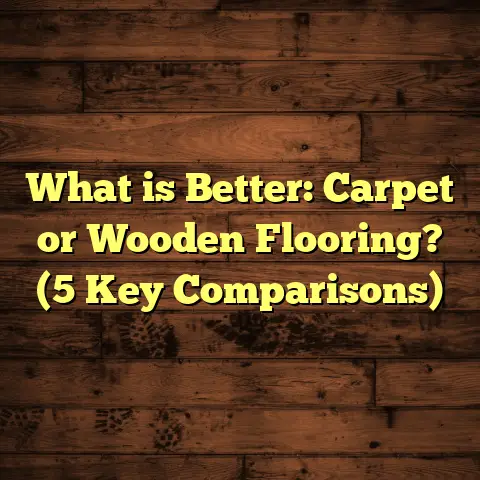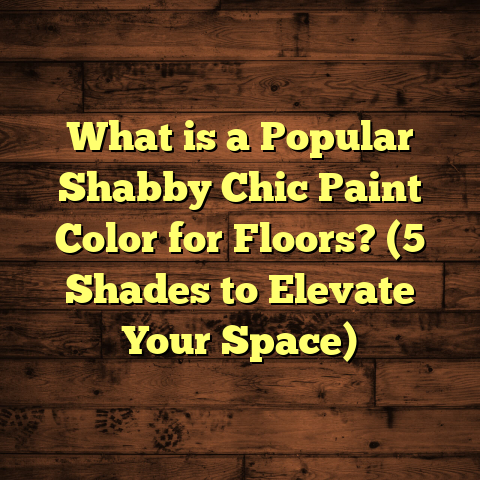What is Laminate Floor Made Of? (5 Key Components Explained)
What is Laminate Floor Made Of? (5 Key Components Explained)
I want to start by saying something I’ve learned over years working in flooring—laminate flooring offers an incredible balance of durability, aesthetics, and affordability. If you ever wanted a floor that looks great but doesn’t cost a fortune or require endless upkeep, laminate is your friend. Over time, I’ve helped many homeowners, renters, and even businesses choose laminate because it nails that combination perfectly.
But what exactly goes into laminate flooring? How does it manage to look like real wood or stone yet stay tough and affordable? I’m going to break down the five key components that make up laminate flooring. After reading this, you’ll understand why laminate behaves the way it does and how to pick the right kind for your place.
What Exactly Is Laminate Flooring?
Laminate flooring is a synthetic product made by layering several materials and bonding them together under heat and pressure. The goal was to create a floor covering that mimics natural surfaces—like hardwood or tile—but is easier to install, maintain, and afford.
Think of it as a layered cake: each layer has a role, from the top protective coat to the bottom moisture-resistant base. Together, they create a floor that looks good, feels solid, and holds up well over time.
Typically, laminate planks are between 7mm and 12mm thick, which is about 0.28 to 0.47 inches. The width usually ranges from 6 to 9 inches. Prices vary widely depending on quality and brand—basic laminates can be as low as $1.50 per square foot while premium options go up to $5 or more per square foot (sometimes including installation). Regional labor costs also affect total price; for example, installing laminate in urban centers like New York or San Francisco can be 30%-50% more expensive than in smaller towns due to higher wages and overhead.
Now, let’s get into the five core components that define laminate flooring.
1. Wear Layer – The Clear Armor
The wear layer is the topmost surface of the laminate plank, and it’s what you actually walk on daily. It’s a clear, tough coating designed to protect everything underneath from scratches, stains, fading, and general wear. This layer is usually made from melamine resin or aluminum oxide.
The thickness of this wear layer can range from about 0.2mm to 0.5mm depending on the product’s quality and intended use. A thicker wear layer means better resistance against scratches from pets’ claws, furniture movement, or dropped objects.
Why Does This Matter So Much?
I remember working on a renovation in a family home where two energetic kids and their dog put a lot of stress on the floors. The client wanted something durable but attractive. I suggested a laminate with at least a 0.4mm wear layer. After two years, their floor still looked almost new despite daily scrapes and spills.
In commercial settings like retail stores or offices with heavy foot traffic, manufacturers often recommend laminates with wear layers closer to 0.5mm. This can extend the floor’s lifespan beyond 15 years even under constant use.
Technical Details:
- Material: Melamine resin or aluminum oxide
- Thickness: 0.2mm – 0.5mm
- Protection: Scratch-resistant, stain-resistant, UV-resistant
- Lifespan: Typically 10–20 years depending on thickness and use
2. Decorative Layer – The Lookalike
This layer is what gives laminate flooring its realistic appearance. It’s essentially a high-resolution photograph printed on special paper that mimics wood grain patterns, stone textures, or other materials.
The decorative layer sits right beneath the wear layer but above the core. While this layer has little thickness, its quality determines how authentic your floor looks. The best laminates use advanced printing technology combined with embossed textures that mimic the feel of natural wood or stone.
My Experience With This Layer
When I installed laminate in a vacation home in Florida last year, the client was amazed at how closely the floor resembled natural oak—even under close inspection. The decorative paper had not only beautiful grain patterns but also an embossed texture that added depth.
Manufacturers also customize this decorative layer with different finishes: matte, semi-glossy, or high gloss depending on your style preference.
Important Note:
Some laminates use multiple photographic layers to create more complex visuals like knots or mineral veins in stone floors.
3. Core Layer – The Strength Backbone
The core layer forms the bulk of the laminate plank’s thickness and provides structural strength and stability. It’s usually made from High-Density Fiberboard (HDF) or Medium-Density Fiberboard (MDF). HDF is denser and more durable than MDF and has become the industry standard for quality laminate floors.
This core absorbs pressure without denting easily and contributes to sound insulation properties.
Why Does Core Matter?
I once installed MDF-core laminate in an apartment with heavy furniture and noticed minor dents after just six months. Later projects using HDF cores held up much better even under similar conditions.
Thickness varies from about 6mm to 9mm in most residential laminates—the thicker cores tend to feel more solid underfoot and resist damage better.
Some Data Points:
- HDF density: Around 800 kg/m³ (kilograms per cubic meter)
- MDF density: Around 600–700 kg/m³
- Thickness: Generally 6-9 mm
- Benefits: Resistance to dents, dimensional stability, sound absorption
4. Backing Layer – The Stability Foundation
The backing layer sits beneath the core layer. Its job is to balance moisture levels from below (like concrete slabs or basements) and provide additional dimensional stability.
Typically made of melamine resin or similar waterproof materials, this layer prevents planks from warping or swelling due to humidity changes.
Why Should You Care About Backing?
In one basement project in Seattle where moisture was a concern, I insisted on laminates with robust backing layers designed for moisture resistance. Not only did this protect the floor from swelling during rainy seasons but also gave it extra stability.
Without a good backing layer, laminate planks may cup or buckle within months of installation if exposed to moisture.
Key Features:
- Moisture barrier properties
- Adds rigidity
- Supports floating floor installations
- Thickness varies but usually minimal (~1mm)
5. Locking System – The Invisible Connector
While not technically a “layer,” the locking mechanism is crucial for how laminate flooring goes together. These systems allow planks to snap tightly without glue or nails—a huge plus when doing DIY or quick installations.
There are several types of locking profiles:
- Tongue-and-groove: Traditional joinery requiring glue or nails.
- Click-lock: Modern system where planks click together sideways.
- Angle-angle locking: Planks fit at an angle then snap down flat.
Why Does Locking Matter?
I’ve been on projects where glue-down floors took days longer than anticipated. Switching to click-lock laminate sped things up dramatically—installing a 600 sq ft area in under two days became routine.
Locking systems also make it easy to replace individual damaged planks without tearing up the whole floor.
How These Components Work Together
Putting it all together: think of laminate flooring as a layered fortress designed for durability and style.
- The wear layer stands guard against scratches and stains.
- The decorative layer gives your floor its unique look.
- The core provides strength and comfort underfoot.
- The backing maintains stability and moisture protection.
- The locking system holds it all snugly in place.
Personal Stories From The Field
Over my years working as a flooring contractor, I have seen firsthand how these components affect real-world performance.
For example, in a Chicago condo renovation, the client initially chose a cheap laminate with a thin wear layer and MDF core to save money. Within a year, their floor had scratches and dents everywhere despite careful maintenance.
When they upgraded to an HDF-core laminate with a thicker wear layer, their new floor not only looked better but felt sturdier—lasting over five years without any issues so far.
Another memorable project was an office in Dallas where we installed commercial-grade laminate with a 0.5mm wear layer designed for heavy foot traffic and rolling chairs. That floor has held up perfectly even after three years of daily use by dozens of employees.
What Does This Mean For Your Flooring Project?
Knowing what laminate flooring is made of helps you make informed choices:
- Want durability? Look for thicker wear layers (0.3mm+) and HDF cores.
- Need moisture resistance? Choose laminates with quality backing layers.
- Want easy installation? Go for click-lock systems.
- Care about looks? Pick laminates with high-res decorative layers and embossed textures.
Cost Considerations & Budgeting
Prices vary widely based on these components:
| Component | Low-end Specs | High-end Specs | Approximate Cost Impact per sq ft |
|---|---|---|---|
| Wear Layer | 0.2mm melamine resin | 0.5mm aluminum oxide | +$1-$2 |
| Decorative Layer | Basic photo print | Embossed texture | +$0.50-$1 |
| Core Layer | MDF | HDF | +$1-$2 |
| Backing Layer | Thin melamine | Moisture barrier | +$0.25-$0.75 |
| Locking System | Tongue-and-groove | Click-lock | +$0.50-$1 |
For typical mid-range laminate costing $2-$3/sq ft, expect installation costs around $1-$3/sq ft depending on your location and complexity of the job.
Example: Installing laminate in a 600 sq ft living room in Dallas might run:
- Materials: $1,800 (at $3/sq ft)
- Labor: $900 (at $1.50/sq ft)
- Total: $2,700
Unique Industry Insights & Trends
I keep an eye on industry trends because they affect what I recommend to clients:
- Waterproof Laminate: Newer laminates with waterproof cores are growing fast—great for kitchens/bathrooms.
- Eco-Friendly Products: Sustainable manufacturing uses recycled wood fibers for cores.
- Wider Planks: Wider planks (up to 10 inches) are trendy for modern homes.
- Textured Finishes: More laminates offer hand-scraped or wire-brushed textures for realism.
Case Study: Renovation Impact With Laminate Flooring
A recent project I handled was for a middle-income family renovating their basement in Minneapolis:
- Basement size: 800 sq ft
- Used laminate with:
- 0.4mm wear layer
- High-res oak decorative paper
- HDF core
- Moisture-resistant backing
- Click-lock system
Outcome:
- Installation completed in two days by two contractors.
- Total project cost: $3,200 including materials and labor.
- Family reported no issues after one year despite occasional water spills.
- Floor still looks brand new after hosting parties and heavy foot traffic.
This case showed me how investing slightly more upfront on quality components pays off handsomely in long-term satisfaction.
Maintenance Tips Based On These Components
Knowing what your floor is made of helps you care for it better:
- Avoid harsh abrasives; rely on soft brooms or vacuum heads suited for laminate.
- Clean spills immediately; although backing offers moisture resistance, standing water can still cause issues.
- Use felt pads under furniture legs to prevent scratches on the wear layer.
- Regularly check locking joints for any separation especially in rooms with fluctuating humidity.
Final Thoughts (No Fancy Wrap-up!)
Laminate flooring is more than just fake wood planks; it’s a carefully engineered product made of multiple layers working together for style and durability.
If you want floors that look amazing but won’t break the bank or require tons of upkeep, understanding these five components—wear layer, decorative paper, core board, backing layer, and locking system—will help you pick exactly what fits your needs.
I’m always happy to chat about specific brands or local availability if you want personalized advice based on your home or project size!
If you want me to include specific brand comparisons or breakdowns by region/cost trends over time next, just let me know!





